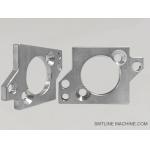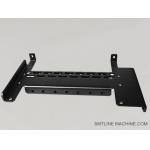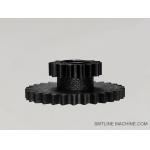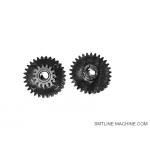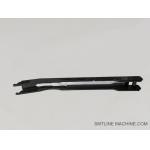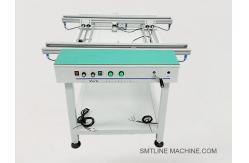Dual track PCB Conveyor
Our company has been in operation for 11 years and will definitely
be your best choice with guaranteed quality and fast delivery
Product Introduction – Dual Track PCB Conveyor
The Dual Track PCB Conveyor is a specialized SMT inline transport
device designed to simultaneously transfer PCBs on two independent
lanes, allowing for high-efficiency operation in dual-lane or
high-mix SMT production lines. It is typically installed between
machines such as screen printers, SPI, mounters, AOI, and ovens,
and is essential for balancing, buffering, or linking dual-lane SMT
equipment.
With ESD-safe construction and SMEMA compatibility, this conveyor
provides smooth, reliable board transfer while saving factory space
and reducing line downtime.
Key Features:
Two fully independent PCB transport tracks
Supports dual-lane synchronous or asynchronous production
Compatible with SMEMA communication for each lane
Adjustable rail width (manual or motorized)
ESD-safe construction (anti-static belts and frame)
Optional buffering, bypass, or accumulation mode
Compact footprint with height-adjustable feet
Technical Specifications:
| Parameter | Specification |
| Function | PCB transport / buffering (dual track) |
| PCB Size | 50 × 50 mm – 460 × 250 mm (per lane, adjustable) |
| Conveyor Direction | Left → Right or Right → Left (customizable) |
| Conveyor Height | 900 ± 20 mm |
| Drive Method | Timing belt with stepper or AC motor |
| Control System | PLC + Touchscreen / Button panel |
| Power Supply | AC 220V, 50/60 Hz |
| Frame Material | ESD aluminum alloy + steel |
| Communication | Dual SMEMA standard interface |
Applications:
PCB transfer between SMT machines (printer, SPI, mounter, AOI)
Dual-lane production balancing
Transport of OK boards from dual-track AOI or test stations
Ideal for LED, automotive, and consumer electronics assembly lines
Optional Features:
Signal tower light (R/Y/G with buzzer)
NG/OK separation logic
Motorized width adjustment
MES connection module
Barcode scanner mount
Safety covers or curtains
Related Accessories – Dual Track PCB Conveyor
1. Mechanical Components
Dual-lane ESD-safe conveyor rails – For secure edge-clamp PCB
transport
Width adjustment mechanism – Manual or motorized screw-type rail
adjuster
ESD timing belts (double) – 6 mm or 8 mm anti-static belts for
smooth PCB movement
Adjustable support feet (M12 type) – Used to stabilize and level
the conveyor
Conveyor frame panels and side guides – Aluminum alloy structure
with insulation
Belt tensioners and pulleys – To maintain belt alignment and
tension
2. Electrical Components
Photoelectric sensors (e.g., Omron E3Z series) – Detect PCB arrival
and position in each lane
Limit switches – For mechanical stroke or width detection
Stepper motors or AC motors (dual-drive) – Drive belts in each lane
independently
Motor driver (Leadshine or equivalent) – Controls stepper motor
speed and direction
Signal tower light (3-color) – Indicates status: running, stop,
error
PLC controller – Manages transport logic, width adjustment, and
signal timing
Touchscreen HMI or push-button panel – Operator interface
SMEMA interface cables (2 sets) – Dual SMEMA for left/right track
integration
3. Pneumatic Components (if equipped with stoppers)
Pneumatic stop cylinders (AIRTAC SDA series) – Stops PCBs in each
lane
Solenoid valve (AIRTAC 4V210-08) – Controls airflow to stoppers
FRL unit (filter + regulator + lubricator) – Maintains air supply
quality
Anti-static PU tubing – For routing air to dual-track components
4. Maintenance / Optional Accessories
Replacement ESD belts – For regular wear and tear
Sensor mounting brackets – Adjustable aluminum holders for
dual-lane detection
Barcode scanner mount – For traceability in each lane
Dust-proof covers (optional) – Acrylic or PVC protective enclosures
Safety light curtain – Protects operators during auto transport
Power switch and emergency stop button – For operation safety and
shutdown control
FAQ Guide – Dual Track PCB Conveyor
1. What is a Dual Track PCB Conveyor used for?
It is used to transport PCBs on two independent lanes
simultaneously in high-speed SMT production lines. Common
applications include connecting dual-lane machines, balancing line
flow, or handling NG/OK boards after inspection.
2. What are the advantages of dual track over single track?
Doubles throughput by handling two lanes at once
Allows parallel production of two board types or processes
Saves space compared to two single-lane conveyors
Ideal for AOI, SPI, printer-to-mounter, or oven output connections
3. Is the conveyor width adjustable?
Yes. Most dual track conveyors have manually or motor-adjustable
rail widths to accommodate different PCB sizes. Each lane may have
its own adjustment or shared mechanism depending on the design.
4. What PCB sizes are supported?
Typically supports 50 × 50 mm to 460 × 250 mm per track
Custom widths are available on request
5. What is the standard conveyor height?
Standard height is 900 ± 20 mm, compatible with SMT line equipment
Adjustable support feet are included to fine-tune the height
6. What control methods are available?
Basic version: Push-button panel
Advanced version: Touchscreen HMI + PLC
Control options include start/stop, width adjustment, speed
control, and alarm reset
7. Is it SMEMA compatible?
Yes. The dual track conveyor includes two sets of SMEMA connectors
(one per lane) for easy inline integration with upstream and
downstream machines.
8. What is the belt type used?
Uses anti-static (ESD-safe) timing belts, typically 6–8 mm wide
Belts ensure gentle, stable PCB movement without electrostatic
damage
9. Does it require air supply?
Only if equipped with pneumatic stoppers or gates
If included, the required air pressure is typically 4–6 kg/cm²
10. What are common optional features?
Signal tower light (R/Y/G with buzzer)
Barcode scanner mount
Motorized width adjustment
MES system integration
NG/OK diverter
Safety light curtain or acrylic covers
11. What are the maintenance requirements?
Clean belts and sensors weekly
Lubricate bearings, pulleys, or guide rails monthly
Inspect belts for wear and replace if needed
Check motor and PLC connections quarterly
12. How long is the delivery time?
Standard models: 3–5 working days
Customized sizes or features: 7–10 working days
We can do for you:
1. We provide fulL SMT solution for you
2. We provide core technology with our equipments
3. We provide the most professional tech service
4. We have wealthy experience on SMT factory setup
5. We can solve any question about SMT
Contact:
CNSMT Electronics Equipment Co,.LTD
Email: info@smtlinemachine.com
www.smtlinemachine.com
Mb/whatsapp/wechat:+8613537875415
SKYPE:smtdwx
